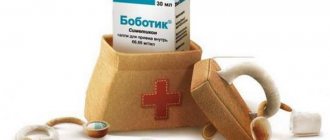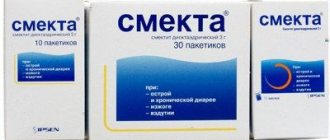December 24, 2016
Averyanova Sveta
Parents of children of different ages face such a problem as constipation. This condition can cause discomfort, so a laxative for children is a sure way to solve the problem.
But its regular use can cause addiction to the body and be harmful to it. Therefore, you need to take it correctly. In addition, you should find out the reasons that caused this state of the body and make every effort to solve them.
Causes of constipation
Constipation is a slow bowel movement or complete absence. This condition is typical for children of different ages, both newborns and those who have reached 2–3 years of age. This issue should be given special attention, since it is easier to solve the problem at the initial stage, when the cause is easy to eliminate, than to treat all the ensuing consequences.
Constipation can occur for the following reasons:
- The child is not eating properly.
- Physical activity is too low.
- Stress was suffered.
- It’s common for a baby to be patient when he wants to go to the toilet.
- Side effects on the body of medications that the baby is taking or has taken.
- Diseases of the anal area.
What medications will help solve the problem?
When faced with the problem of constipation for the first time, parents should consult a doctor who will tell you which laxatives for children can give good results. They may also be given recommendations on how to solve the problem without medication.
For example, in some cases it is enough to adjust the baby’s eating and drinking habits.
Massage and heat applied to the baby's belly can also give good results.

If these recommendations do not lead to positive changes, then you should resort to medications from the following groups:
- Volumetric. Their feature is the binding of fluid that is located in the intestinal lumen, due to which its volume increases. This leads to the process of defecation.
- Annoying. Due to a special chemical composition, irritation of the receptors in the wall of the digestive organ occurs.
- Osmotic. The process of defecation occurs due to the fact that salts are no longer absorbed by the body, and feces increase in volume.
Children's remedies for constipation come in different forms. Therefore, the problem that has arisen can be solved at any age. For example, the most relevant forms of laxatives are:
- Candles.
- Syrups.
- Drops.
- Microclysters.
- Pills.
The selected product must be effective and safe. In the first case, only a consultation with a doctor will allow you to decide which drug will give the best result. As for safety, when purchasing, you should study the instructions for use, all kinds of side effects and contraindications.
When choosing a laxative for a child, you should pay attention to the fact that it:
- It had a gentle effect on the body.
- Its active substances were aimed only at solving the problem, and not at the entire body.
- It did not affect the body's absorption of salt.
- It was manufactured by a trusted manufacturer who has earned a positive reputation.
- Appropriate for the child's age.
What means are prohibited to use?
The dominant principle in the treatment of constipation in newborns is the harmlessness of the drugs used.
- When a child switches from breastfeeding to mixed or artificial feeding, bowel movements may be delayed for several days, and the color and consistency of stool may change. The delay does not require treatment; the body needs to be given time to adjust to the new diet. Medicines can interfere with this process.
- It is forbidden to independently use laxatives for a newborn child for severe constipation, taken orally.
- Forget about home and folk methods of causing a bowel movement in a child by irritating the rectum with the tip of a thermometer or syringe. You cannot use candles made from laundry soap, or make various enemas from kefir, soda solution, or mother's milk. This can lead to injury to the rectum and disrupt the natural intestinal microflora.
- The use of microenemas and suppositories is carried out once, not on an ongoing basis. If the suppository did not help, the child was unable to defecate, do not continue self-treatment, call the pediatrician.
- If your child has a hard, swollen tummy, constipation for more than two days, or is lethargic and tearful, you should immediately consult a doctor. A diagnosis of intestinal obstruction is possible.
- Children under one year of age are prohibited from being prescribed saline or osmotic drugs, oil-based laxatives, and medications that are absorbed through the blood.
Loading …
Product for babies
Constipation can strike a baby at one or three years old, when adult food is already present in his diet, which can become one of the reasons for a rather unpleasant change in the body. Infants may also have problems with bowel movements, and at this age it is difficult to find an effective and gentle laxative.
After all, the baby’s body is still weak and how it will react to the new drug is unknown. For this reason, experts recommend not to conduct experiments, but to use proven and trustworthy drugs:
- Glycerol.
- Microlax.
- Duphalac.
- Forlax.
All the drugs given as an example differ in their release forms, but almost all of them are suitable for babies from the first days of life to 2 years. Before you begin to solve a delicate problem, you should understand the action of these drugs, the correct dosage and become familiar with possible side effects.
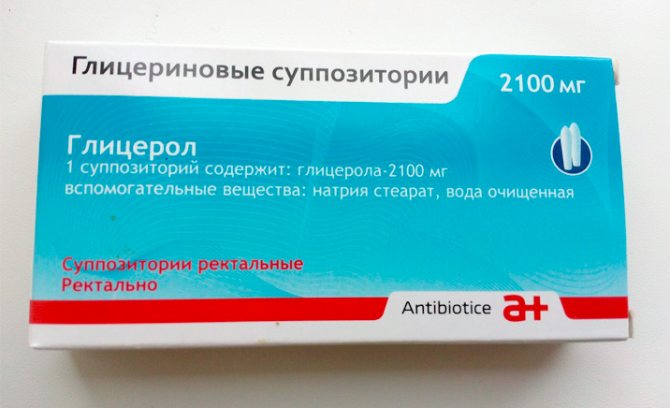
Glycerol is a fast-acting laxative whose active ingredient is glycerin. Available in the form of candles that can be used for newborns. The principle of action is that after rectal administration of the suppository, its active substance begins to irritate the intestinal wall, making it liquid and facilitating its removal from the body naturally.
Experts do not recommend using Glycerol for regular use. This is due to the fact that the drug can lead to problems with the rectum, in particular, irritation of its mucous membrane.
In order to help a newborn, it is enough to use one candle.

A simple way to solve the problem is the complex action microenema Microlax. The laxative effect is achieved due to sorbitol and sodium citrate included in the composition. Thanks to these components, irritation of excrement occurs and an increase in fluid in the intestinal lumen. In addition to the laxative effect, which occurs quite quickly, the baby may experience itching in the anal area.
When using Microlax, you should follow the dosage prescribed for a certain age. So, for newborns and children under 3 years of age, the recommended dosage is half a microenema. If a 3-year-old child or older is experiencing constipation, then a whole microenema will be needed.
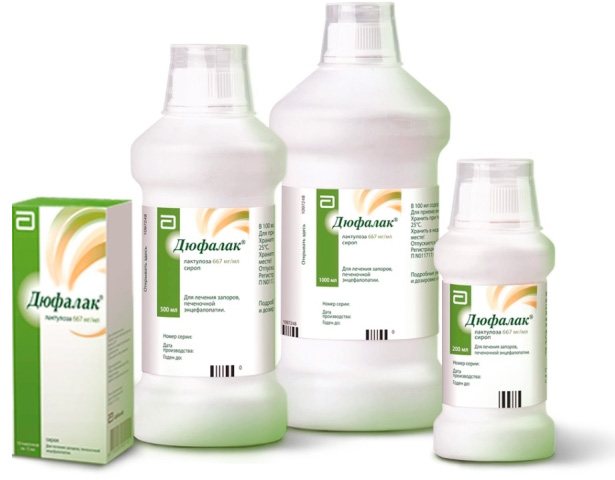
The best laxative for newborns, according to most experts, is Duphalac . This is a mild and effective product that contains lactulose, which is known to be a natural fiber.
The convenient form of the syrup allows you to easily give the required dose to your baby in its pure form or by mixing it with breast milk, water or any other liquid. Most experts recommend Duphalac for the following reasons:
- There is no absorption into the organ wall.
- The body does not get used to the effect of the drug.
- Duphalac is a prebiotic that helps increase beneficial microflora in the intestines.
- Can be used for a long time.
It is not recommended to start taking the drug with large dosages.
To begin with, the baby should be given 1 milliliter of syrup every 24 hours. The lack of result indicates that the dosage is small and should be increased. This should be done no more than 0.5 milliliters every 3 days. The daily dosage of Duphalac for children under 4 years of age should not exceed 5 milliliters.
You should also know that this drug, despite its positive aspects, is not intended to solve the cause of constipation. Its actions are aimed only at removing feces and cleansing the intestines. You also need to take into account the side effects of taking it in the form of increased gas formation.
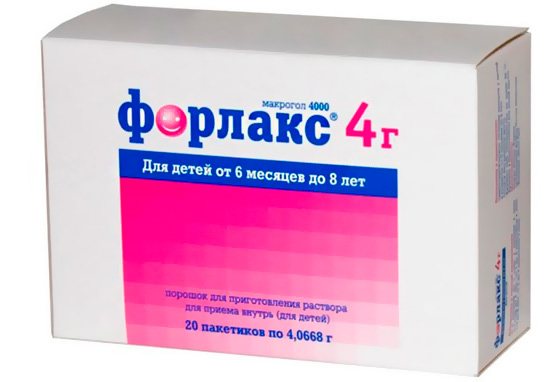
Forlac has a laxative effect on the children's body, and its principle of action is similar to Duphalac. But there is a difference in that Forlak is not a prebiotic, but a synthetic product that contains polyethylene glycol.
This remedy can be prescribed to children who are six months old. The recommended dosage is 4 grams per day. Taking the drug may cause pain in the abdominal area.
Before giving your baby any laxative, you should consult a doctor. This is necessary in order to select the most effective and harmless drug. This will also allow you to avoid most side effects and health problems that may arise due to the presence of intestinal abnormalities in the child or surgical pathology, for which most drugs are contraindicated.
Types of drugs
Choosing the right constipation medication for young children is not easy. Each of the drugs has its own contraindications and features of use. The main selection criterion is the age range:
- For children from birth to three years, a laxative in the form of drops, rectal suppositories or syrup is suitable;
- For older children, it is recommended to give the medicine in powder or in the form of chewable lozenges;
- Teenagers can take laxative tablets.
Microclysters can be given to children of any age; suppositories are introduced into practice from 3 months.
Special requirements apply to constipation medications for newborns. It should be simple and easy to use, give quick and soft results, have no dyes or taste improvers in its composition, and not be addictive.
Let's see what laxatives are recommended for children.
Irritant laxatives for children
These drugs are effective, act quickly, but harshly. They irritate intestinal peristalsis, causing the walls to contract and push feces out. They are rarely prescribed to children and only after 4 years.
Main representatives of the group:
- Slabicap;
- Guttalax;
- herbal laxatives (senna, buckthorn, rhubarb);
- fruit lozenges Regulax, Kafiol;
- castor oil, glycerin.
The result after taking irritants occurs within 6–10 hours.
The advantages of the drugs include fast action and low price, the disadvantages are the depletion of receptors, after which laxatives become ineffective.
Let's look at the most popular irritating medications:
- Guttalax. Fast-acting agent in tablets and solution. Used for immediate defecation. Children from 4 years of age are prescribed a dosage of 5–10 drops once a day, before bedtime. Defecation occurs after 8 hours. The cost of the drug in capsules, current as of January 2020, is 215 rubles, in drops – 350 rubles.
- Senade. Laxative of plant origin. Children 7–12 years old are prescribed ½ tablet once a day. For adolescents over 12 years of age, the dosage is doubled. A package of Senade No. 20 costs 22 rubles.
- Slabicap. Used for children 4 years and older. The initial dose is 5–8 drops, then, if well tolerated, the amount of medication can be increased. It is recommended to take it at night, 1 time per day. A 10 ml bottle of Slabicap costs 70–100 rubles.
Laxatives with irritating effects should not be given to children for more than 7 days, otherwise intestinal tone decreases and constipation only gets worse.
Osmotic laxatives for children
The safest and most reliable children's laxative. Osmotics, entering the digestive tract, slow down the absorption of liquid by the intestinal walls, which helps to increase the volume of feces and soften them. They act more slowly than irritating laxatives - the effect occurs after 12-36 hours.
List of osmotic agents for children:
- Duphalac;
- Forlax;
- Gudlag.
The advantage of laxatives in this group is the safety of use - they do not cause addiction and “lazy bowel” syndrome, have few contraindications and can be used for children from birth. In addition, osmotic agents not only eliminate, but treat constipation.
Disadvantages include slow action and the likelihood of dehydration with prolonged use.
Duphalac syrup is recognized as one of the best laxatives for children. The drug is the only approved remedy for constipation in newborns and can be prescribed from the first days of life at a dosage of 1–3 ml/kg per day. If the initial portion of the laxative is insufficient, it can be doubled. For chronic constipation, the instructions for use allow the use of Duphalac for a long time - at least 2.5–3 months. A 200 ml bottle of syrup costs 225 rubles.
Forlax also has a good osmotic effect. Prescribed to children from six months of age, ½ sachet per day. After a year, the dosage increases to 1–2 sachets per day. It is better to give a laxative in the morning, dissolving the powder in a small amount of water. A package of 20 sachets costs an average of 250 rubles.
Goodluck syrup with a caramel scent is considered a mild and safe laxative for children. Used to treat constipation from 6 months. The initial daily dose is 5 ml, with age the amount of the drug increases to 10–16 ml. The syrup has virtually no side effects. The price of a 200 ml bottle is 250–260 rubles.
Bulk laxatives for children
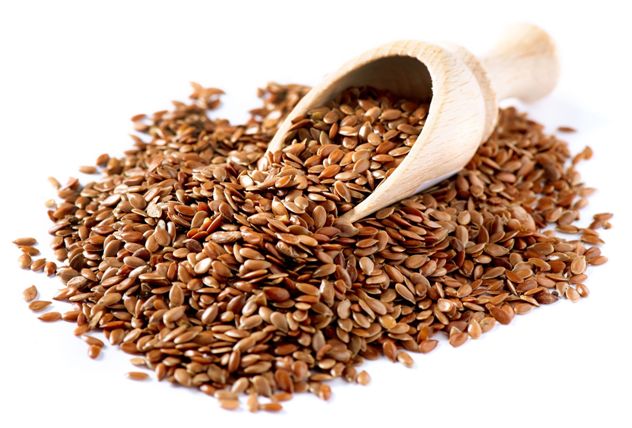
Photo from roxelly.com
These laxatives contain natural or synthetic dietary fiber. Once in the gastrointestinal tract, they swell and increase the volume of intestinal contents. This improves peristalsis and stimulates emptying. The effect occurs 10–12 hours after taking the medicine.
Bulk laxatives (fillers) recommended for younger children:
- Flax seed. For constipation in a newborn, 1 tsp. raw materials, pour 100 ml of boiling water, leave for 15 minutes and filter. The resulting mucus is given to the baby 2-3 times a day. Older children are given 1 tsp of swollen seeds. appointment. A 100 g package costs 64 rubles.
- Kelp. It acts very gently, in addition to combating constipation, it saturates the growing body with vitamins and iodine salts. Used from 1 year of age, 5 mg 1 time per day after meals in the form of crushed raw materials.
The fillers have a mild laxative effect, do not cause addiction or adverse reactions, and can be given to the baby for a long time.
Among the disadvantages, mention should be made of the slow onset of results and the need to wash down dietary fiber with plenty of water. Not every child can do this.
Prebiotics
A mild and safe laxative for newborns. All drugs in this group contain carbohydrates, which lower pH and promote the rapid proliferation of beneficial microflora in the intestines. In addition, prebiotics have a mild but intense laxative effect, which occurs after 2-3 days.
This group of medicines includes:
- Lactulose. The syrup is prescribed to children aged 1.5 months. A single serving is 10–15 mg and depends on the degree of constipation. Newborns receiving artificial nutrition are given 5 mg of laxative per day. The price of children's Lactulose is on average 190 rubles.
- Bifiform Baby. Used for newborns and children up to 3 years old. A single dosage is 0.5 g. It is recommended to mix the laxative with breast milk or other food and give it to the child during dinner. The price for Bifiform Baby 7 ml is on average 400–500 rubles.
- Bifiform Baby in sachet and chewable tablets. The powder is prescribed to children under three years of age, one sachet for 5 days. From the age of 4 the dosage is doubled. Children under 2 years old are given one tablet per day, then the number of lozenges is increased. The cost of the drug Bifiform Malysh does not exceed 350 rubles.
A huge advantage of prebiotics is their naturalness and lack of addiction. The drugs practically do not cause unwanted reactions and are well tolerated by the child’s body.
The disadvantages could be the slow action of prebiotics, but they have a more stable and long-lasting therapeutic effect than any of the laxatives.
Oils (detergents)
Drugs in this group soften stool, make it more plastic and facilitate movement through the gastrointestinal tract. They work mainly at the level of the small intestine and begin to act 4-6 hours after administration.
Fennel, almond or olive oils are most often used to treat constipation in children. The principle of their action and the dosage regimen are the same - 5-25 mg of the drug per day, 2 hours after dinner. The dosage depends on the age and tolerance of the drug.
The advantages of oil laxatives include a quick effect and low price, the disadvantages are an unpleasant taste, nausea, belching and heaviness in the right side after taking them.
The cost of a bottle of any of the oils in a pharmacy does not exceed 50 rubles. The olive product can be purchased in the store for 200–300 rubles.
Candles and microenemas
These contact agents have a quick effect (15–20 minutes), but only work in the rectum. This property is considered to be the main advantage of local laxatives - without penetrating into the gastrointestinal tract, the drugs have minimal damaging effects on the baby’s internal organs.
Suppositories for constipation are allowed to be used by children from 3 months. In pediatrics they use:
- Glycerin suppositories (Glycelax) are the softest and safest for children. Recommended for use once a day. The price of package No. 10 is 115–120 rubles.
- Sea buckthorn suppositories are a herbal remedy with a very mild laxative effect. The cost of 10 pieces does not exceed 70 rubles.
- Calciolax, Ferrolax - gas-forming suppositories. Approved for use only from 2 years of age. Not available in all pharmacies, they cost around 50 rubles per pack.
Another excellent remedy for constipation in newborns and children under 1 year of age are Microlax microenemas. The laxative is in individual tubes equipped with a convenient tip. After administering the gel, the child should be placed on his stomach and wait 15–30 minutes. The drug does not cause adverse reactions, but you should not use it too often - “lazy bowel syndrome” may develop. The price of 4 microenemas is 700–1000 rubles.
Folk remedies
For mild constipation, the problem can be eliminated with the help of alternative medicine recipes. If your baby is fed artificial formula, you can add ½ tsp to the food. olive oil or apply to tongue. When breastfeeding, it is recommended to apply oil to the nipple and offer it to the baby. Do this 3-4 times a day.
Before and after feeding, it is good to give the baby some dill water or chamomile tea (brew 1 teaspoon of the herb with a glass of boiling water, cool and strain). If the child is already 4 months old, you can offer liquid porridge with the addition of oatmeal.

Photo from the site postila.ru
A strong decoction of dried fruits - prunes, dried apricots and rose hips - gives a good laxative effect. The infusion is easy to prepare, and unused fruit can be chopped and added to food. Folk remedies that help relieve constipation in young children include agave leaves. The juice is squeezed out of them and mixed with honey in a 1:1 ratio. Give the child 1/2 tsp three times a day. before meals.
Before using any of the above remedies, you should consult your pediatrician.
Product for children over 3 years old
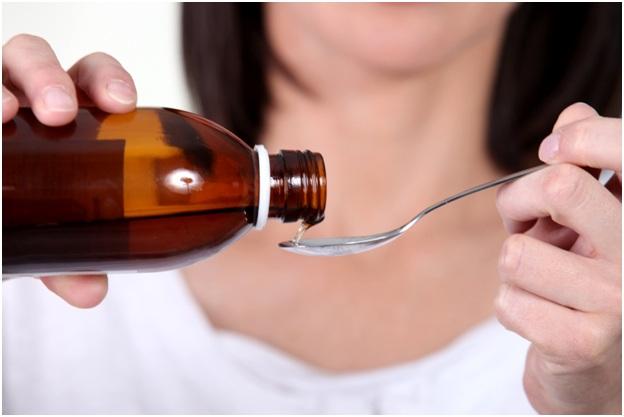
Poor nutrition, stress, and much more can cause constipation in children 2–3 years of age and older.
They, like babies, need help, and it can be provided with the drugs mentioned above. In addition to them, you can use other methods to solve the problem, because older children, in most cases, are sympathetic to their use. Therefore, parents should make sure that their home medicine cabinet contains the following items:
- Vaseline oil . 1-2 tablespoons of oil, drunk before meals, will help speed up the process of bowel movements without being absorbed by the body. But it is not recommended to use it often, as side effects may occur, including weakened intestinal motility, as well as a lack of vitamins (A, E).
- Xylitol and Sorbitol are polyhydric alcohols. Once in the body, they begin to act by retaining water in the intestinal lumen, due to which it is possible to remove all the contents. In order to help the baby, you need to give him a solution prepared from 100 milliliters of water and one sachet of the substance.
- Guttalax is a synthetic drug containing triarylmethane. Its action applies exclusively to the rectum. The process of defecation occurs due to the fact that its peristalsis increases. Available in drops.
The recommended dosage is no more than 5 drops, which should be mixed in a teaspoon with any liquid. Like any other drug, Guttalax has side effects, which include diarrhea, loss of potassium and sodium from the body.
Rating of laxatives for children
The most common and popular form of laxatives can be called syrups; powders for dissolution, drops are less common, followed by tablets and capsules, suppositories and microenemas.
Laxative syrups
Parents like the syrup form because children do not perceive drugs in this form as something unpleasant and take them easily (with food or drink, if necessary).
Duphalac
– soft and easy to use.
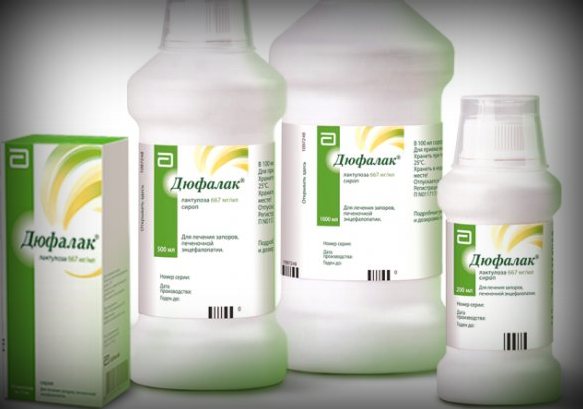
Duphalac is a children's laxative in syrup form based on the action of lactulose. This is the mildest active ingredient, drugs based on which can be given almost from birth. Children are prescribed a dosage of 2.5 ml - 5 ml per day, depending on age and weight.
Duphalac
Advantages:
- suitable for the little ones;
- safe, has a mild effect;
- available.
Flaws:
- the price is above average.
Help
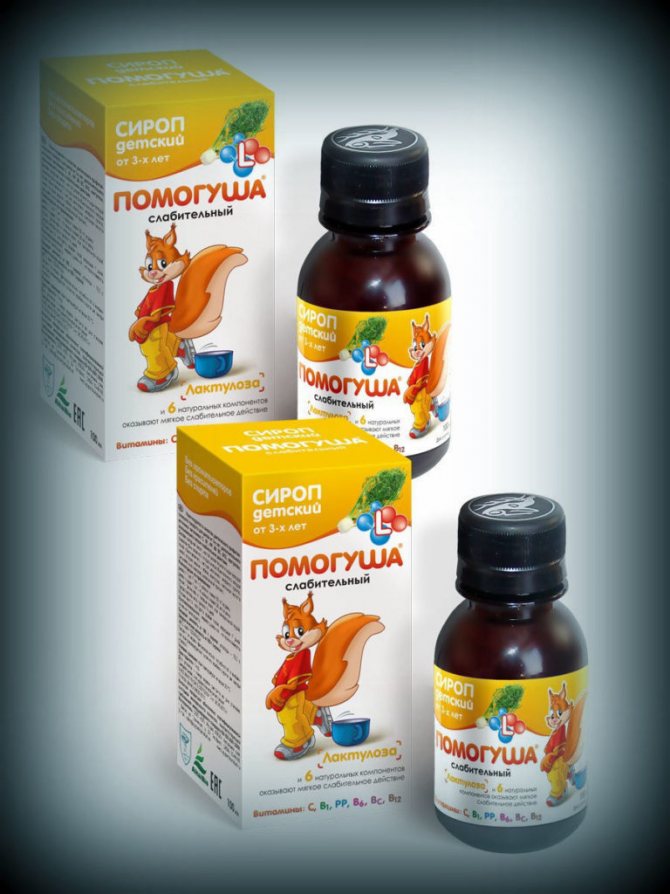
- herbal preparation.
Produced in the form of syrup, the drug “Pomogusha” has natural ingredients. It is an infusion of plant materials (fennel, anise, cumin) and the already familiar lactulose.
The syrup is suitable for children over 3 years of age and has a gentle effect. “Pomogusha” also includes vitamins B and C, with a general strengthening effect.
Help
Advantages:
- natural ingredients;
- pleasant to the taste;
- low price.
Flaws:
- There are age restrictions.
.
Normolakt
-suitable for long-term use.
The drug also contains lactulose as the main active ingredient. Due to its mild effect on the intestines, the drug can be prescribed for long-term use. It is a budget analogue of Duphalac.
Normolakt
Advantages:
- soft impact;
- is not addictive;
- low price.
Flaws:
- has side effects (flatulence);
- has contraindications.
Powders for preparing solutions
The sachet form is convenient for taking on the go, and besides, manufacturers specially develop preparations with a pleasant taste.
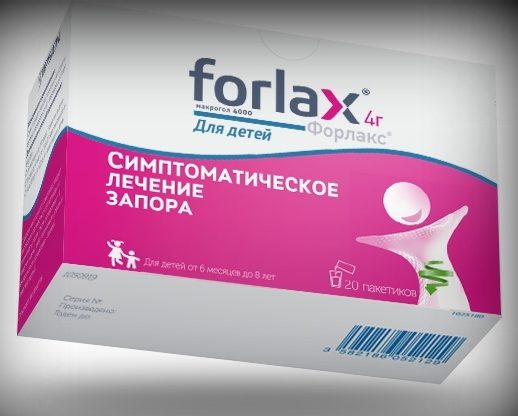
Forlax
- the most popular.
"Forlax" is available in several forms - sachets with powder for preparing a solution and tablets. For children from 6 months to 8 years old, use the powder. The solution has a pleasant taste, reminiscent of orange juice.
The drug quickly but gently stimulates the colon and eliminates even long-term constipation in just 1-2 doses. The drug is taken once a day, with different dosages (depending on age).
It is better to take the drug in the morning. The drug is prescribed for chronic constipation for a period of up to 2-3 months.
Forlax
Advantages:
- pleasant taste:
- impact effectiveness;
- there is no addiction.
Flaws:
- relatively high price.
Transipeg
– with apple and lemon flavors.
"Transipeg" is another medicine in powder form with the main active ingredient macrogol. Suitable for ages over 1 year. The dissolved drug has the taste of lemon or apple, which kids usually like.
Transipeg
Advantages:
- the drug is excreted from the body unchanged (not absorbed in the intestine);
- does not have an irritating effect on mucous membranes.
Flaws:
- the effect of application is not achieved immediately (after 1-2 days).
Fitomucil
– restores microflora.
This natural remedy not only gently cleanses the intestines, but also helps restore microflora. Available in powder form, which can be mixed with juice or porridge.
Fitomucil
Advantages:
- helps restore the natural intestinal microflora.
Flaws:
- has an age limit (from 3 years);
- the price is average.
Fibrolax
– cleanses naturally.
Fibrolax is a powder for preparing a suspension that has a laxative effect due to the shell of psyllium seeds. The coarse fiber contained in the preparation not only cleanses the intestines, but also has the additional effect of removing excess cholesterol.
Some doctors classify Fibrolax as a biological supplement. This dietary supplement can be taken from 3 years of age.
Fibrolax
Advantages:
- effective;
- made from natural ingredients;
- is not addictive;
- low price.
Flaws:
- the effect is achieved over a long period of time;
- has age restrictions.
Drops to relieve constipation
Laxative drugs in this form have recently been produced less frequently, but they are quite convenient to use (can be dissolved in drinks or added to food).
Guttalax
- guaranteed result.
For children, this drug is recommended from 1 month. Laxative drops specially developed for children are a synthetic drug containing triarylmethane.
The effect of the substance applies only to the rectum. The recommended dosage starts from 1 drop for newborns and should not exceed 10 drops for the oldest.
Guttalax
Advantages:
- effectiveness is time-tested;
- Convenient packaging with a dispenser.
Flaws:
- not suitable for frequent use;
- has side effects;
- not suitable for long-term use.
Tablets and capsules
Medicines and dietary supplements produced in the form of tablets are recommended for use from the age of 6 years, due to the characteristics of patients (it is difficult to persuade them to swallow a tablet). Capsules are usually even larger. Therefore, they are recommended for use from the age of 10 years.
Laxatin
– a preparation with herbal ingredients.
Laxatin tablets gently stimulate the motility of the large intestine and eliminate long-term constipation in one or two applications.
It is of plant origin. Popular for a first aid kit when traveling.
Laxatin
Advantages:
- easy to use;
- low price;
Flaws:
- long period of action;
- addictive.

Castor oil
In the form of capsules, you can buy a well-known remedy at the pharmacy - castor oil. Castor oil has a pronounced laxative effect.
Castor oil
Advantages:
- effective;
- has no age restrictions;
- low price.
Flaws:
- the dosage must be carefully observed to avoid side effects;
- cannot be used for a long time.
Suppositories
Medicines in the form of rectal suppositories can be used to alleviate the condition of the youngest patients.
Glycerol
– Suitable for very young children.
Glycerol - suppositories containing glycerin are suitable for one-time use. This is a fast-acting laxative, the active substance of which is glycerin.
Sold in the form of candles that can be used for newborns.
Suppositories
Advantages:
- acts quickly and effectively;
- has no age restrictions;
- convenient to use.
Flaws:
- causes a lazy bowel effect;
- rarely occurs.
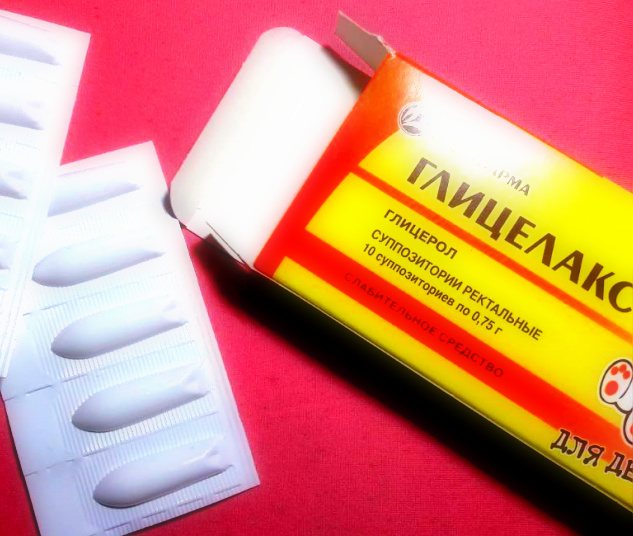
Glycelax
- a budget option.
Glycelax is an analogue of Glycerol with a lower price. This remedy has a gentle effect on the intestines, but is recommended for one-time use. Can be used to treat babies from 3 months.
Glycelax
Advantages:
- low price;
- soft impact.
Flaws:
- has contraindications:
- not made from natural ingredients.
Microclysters
A safer way to cleanse the intestines is microenemas. These medications are produced in the form of tubes with a tip that facilitates the entry of the active substance directly into the rectum. The action time of the product is from 10 minutes.

Microlax
- a popular fast-acting remedy.
Microlax is an effective, easy-to-use drug. The main effect is exerted by sodium citrate, which stimulates the flow of water into the intestines.
Microlax
Advantages:
- speed of impact;
- ease of use;
- convenient form for reception.
Flaws:
- expensive product;
- Long-term use is not recommended.
Proctum
- a budget option.
A domestic budget analogue of Microlax, which costs almost 2 times less. However, there is an age limit: use is recommended from 2 years.
Proctum
Advantages:
- contains components that allow healing microcracks;
- helps restore your own microflora;
- low price.
Flaws:
- there are difficulties with acquisition;
- age restrictions.
Products based on natural oils

Products based on natural oils have been used in folk medicine for a laxative effect (including in children) for quite a long time. Natural oils are a good alternative to chemical-based drugs.
Linseed oil
Flax seed oil is a natural laxative. This product has no restrictions for children (the main thing is to know the correct dosage).
Vaseline oil
Advantages:
- has no side effects;
- made from plant ingredients.
Flaws:
- relatively high price.
Vaseline oil
Vaseline oil is obtained during the processing of highly purified petroleum products. This oil has also been used for quite a long time to combat constipation. Suitable for the treatment of constipation in children from 2 years of age.
Its components are poorly absorbed into the intestines and have no effect on the microflora. It can be used in several forms - as part of an enema or simply drunk from a small spoon.
Vaseline oil
Advantages:
- mild effect on the body;
- low price.
Flaws:
- chemical drug, has a side effect;
- suitable for one-time use;
- may cause a “lazy bowel” effect.
In addition to the above oils, olive and sunflower oil have a laxative effect. They must be taken orally before meals (dosage - from 1 teaspoon).
Traditional methods that can replace laxatives
You can solve your constipation problem without using a baby laxative.
For example, in order to improve the functioning of a baby’s intestines, a nursing mother should reconsider her diet.
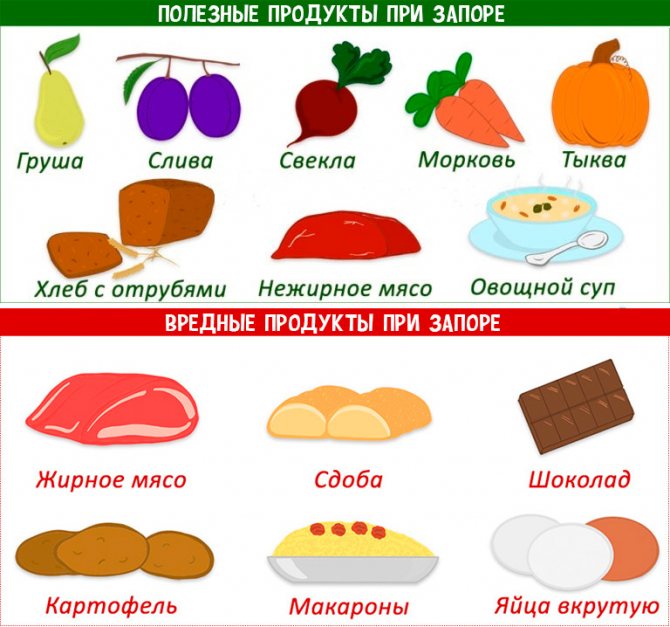
In addition to the fact that it should be balanced and complete, it should also contain products that have a laxative effect on the body, and these are:
- Pumpkin.
- Cabbage.
- Plum.
- Dried apricots.
- Figs
- Bran.
- Zucchini.
The same products should be present in the diet of children over 3 years old. need to be given liquid throughout the day . A good result can be obtained by preparing a laxative at home, which in its effect can be compared with medications. But there will be no harm to the body from taking it.
When to see a pediatrician
Only a pediatrician will correctly assess the situation and make the right decision in choosing treatment methods.
If your baby has prolonged constipation or traces of blood in the stool, be sure to visit a doctor to rule out other diseases. In addition to a carefully collected medical history to determine the duration of the condition, the pediatrician will recommend an examination of the abdominal cavity, rectum, and anus. The microflora of the colon is examined for dysbiosis and a scatological test is carried out.
Prolonged constipation in a child can be a concomitant factor of some serious diseases:
- anemia;
- pathologies of intestinal patency, undeveloped nerve cells in one of the sections of the intestine, polyps, tumors;
- rickets:
- neurological problems;
- abnormalities in the functioning of the thyroid gland.


